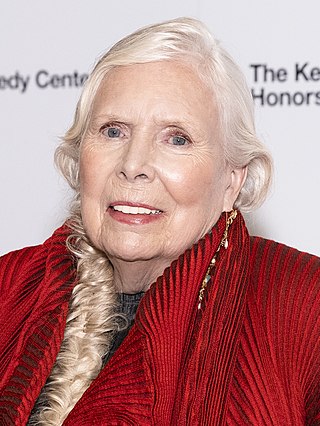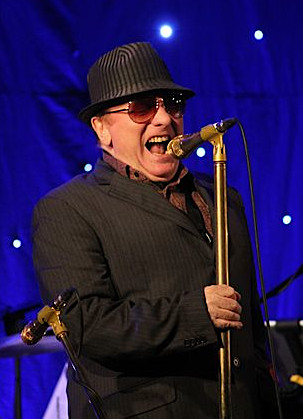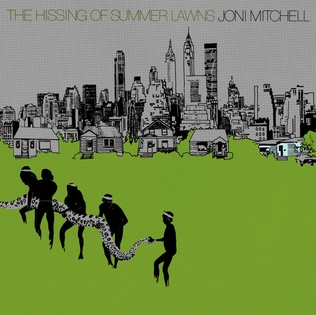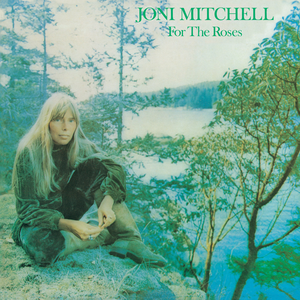Related Research Articles

Roberta Joan "Joni" Mitchell is a Canadian-American singer-songwriter, multi-instrumentalist, and painter. She is widely considered one of the greatest singer-songwriters of all time. As one of the most influential singer-songwriters to emerge from the 1960s folk music circuit, Mitchell became known for her personal lyrics and unconventional compositions which grew to incorporate pop and jazz elements. She has received many accolades, including eleven Grammy Awards and induction into the Rock and Roll Hall of Fame in 1997. Rolling Stone called her "one of the greatest songwriters ever", and AllMusic has stated, "Joni Mitchell may stand as the most important and influential female recording artist of the late 20th century."

Sir George Ivan MorrisonOBE is a singer-songwriter and musician from Northern Ireland whose recording career spans seven decades.

Moondance is the third studio album by Northern Irish singer-songwriter Van Morrison. It was released on 27 January 1970 by Warner Bros. Records. After the commercial failure of his first Warner Bros. album Astral Weeks (1968), Morrison moved to upstate New York with his wife and began writing songs for Moondance. There, he met the musicians that would record the album with him at New York City's A & R Studios in August and September 1969.

Astral Weeks is the second studio album by Northern Irish singer-songwriter Van Morrison. It was recorded at Century Sound Studios in New York during September and October 1968, and released in November of the same year by Warner Bros. Records.

The Hissing of Summer Lawns is the seventh studio album by Joni Mitchell. It was released in November 1975 on Asylum Records. The album continues the jazz-influenced sound of Mitchell's previous album Court and Spark while featuring more unconventional and experimental material than its predecessor. Additionally, the album saw Mitchell experiment with sampling and synthesizers such as the Moog and ARP. Contributors to the album include jazz-rock groups the L.A. Express and the Jazz Crusaders alongside backing appearances by James Taylor, David Crosby, and Graham Nash.

David Kenneth Ritz Van Ronk was an American folk singer. An important figure in the American folk music revival and New York City's Greenwich Village scene in the 1960s, he was nicknamed the "Mayor of MacDougal Street".

Veedon Fleece is the eighth studio album by Northern Irish singer-songwriter Van Morrison, released in October 1974. Morrison recorded the album shortly after his divorce from wife Janet (Planet) Rigsbee. With his broken marriage in the past, Morrison visited Ireland on holiday for new inspiration, arriving on 20 October 1973. While there he wrote, in less than three weeks, the songs included on the album.

His Band and the Street Choir is the fourth studio album by Northern Irish singer-songwriter Van Morrison. It was released in November 1970 by Warner Bros. Records. Originally titled Virgo's Fool, Street Choir was renamed by Warner Bros. without Morrison's consent. Recording began in early 1970 with a demo session in a small church in Woodstock, New York. Morrison booked the A&R Studios on 46th Street in New York City in the second quarter of 1970 to produce two sessions of songs that were released on His Band and the Street Choir.

Saint Dominic's Preview is the sixth studio album by Northern Irish singer-songwriter Van Morrison. It was released in July 1972 by Warner Bros. Records. Rolling Stone declared it "the best-produced, most ambitious Van Morrison record yet released."

For the Roses is the fifth studio album by Canadian singer-songwriter Joni Mitchell. It was released in November 1972, between her two biggest commercial and critical successes—Blue and Court and Spark. In 2007 it was one of 25 recordings chosen that year by the Library of Congress to be added to the National Recording Registry.

Beautiful Vision is the thirteenth studio album by Northern Irish singer-songwriter Van Morrison, released in February 1982. It continued Morrison's departure from R&B at the time, instead favoring Celtic folk and American jazz in its music. As with many of Morrison's recordings, spirituality is a major theme and some of the songs are based on the teachings of Alice Bailey. Other songs show Morrison's Celtic heritage and reminiscence of his Belfast background.

Blue Light 'til Dawn is a studio album by American jazz singer Cassandra Wilson. Her first album on the Blue Note label, it was released in 1993. It contains Wilson's interpretations of songs by various blues and rock artists, as well as three original compositions. The album marked a shift in Wilson's recording style, mostly dropping the electric instruments of her earlier albums in favor of acoustic arrangements. A critical and commercial breakthrough, the album was re-released in 2014 with three bonus tracks recorded live somewhere in Europe during the Blue Light 'til Dawn Tour. The eponymous single was nominated for the Grammy Award as Best Jazz Vocal Performance.

Blue River is an album by folk rock musician Eric Andersen, released in 1972. The album was reissued in 1999 by Columbia Legacy with two extra tracks.

"Moondance" is a song recorded by Northern Irish singer and songwriter Van Morrison and is the title song on his third studio album Moondance (1970). It was written by Morrison, and produced by Morrison and Lewis Merenstein.
"Cyprus Avenue" is a song written by Northern Irish singer-songwriter Van Morrison and included on his 1968 album Astral Weeks. It refers to Cyprus Avenue, a residential street in Morrison's hometown of Belfast, Northern Ireland.
"Sweet Thing" is a song by Northern Irish singer-songwriter Van Morrison, released on his second studio album Astral Weeks (1968). It was on the first side of the album, that was under the heading: In the Beginning. The song was later used in 1971 as the American B-side to Morrison's single "Blue Money".
"The Way Young Lovers Do" is a song by Northern Irish singer-songwriter Van Morrison from his second solo album, Astral Weeks. It was recorded in 1968, at Century Sound Studios New York City, during September and October of that year. The song is in triple metre. The distinctive feel of the original recording emerges from the non-rock style of double-bass phrasing by veteran jazzman Richard Davis and additional jazz musician session players, which combined with Morrison's soulful vocals, creates a relatively unusual combination of stylistic elements.

Live at Montreux 1980/1974 is the first official DVD by Northern Irish singer-songwriter Van Morrison. It was released on 16 October 2006. The films consist of two separate performances by Van Morrison at the Montreux Jazz Festival in Switzerland. It was certified gold in May 2007 and platinum in June 2009.

Astral Weeks Live at the Hollywood Bowl is the fifth live album recorded by Northern Irish singer/songwriter Van Morrison, and released in the UK on 9 February 2009, and in the United States on 24 February 2009. It was recorded during two live concerts at the Hollywood Bowl in Los Angeles, California in 2008 and released on Morrison's new Listen to the Lion label and distributed by EMI.

The Essential Van Morrison is a two-disc compilation album by Northern Irish singer-songwriter Van Morrison, released on August 28, 2015. It is part of Sony BMG's Essential series of compilation albums and includes tracks from Morrison's solo output, as well as tracks from his days with Them. The tracks consist of some of Morrison's biggest hits and popular album tracks from 1964 as leader of the Northern Irish band Them through his 2009 release Astral Weeks Live at the Hollywood Bowl. The liner notes were contributed by David Fricke.
References
- 1 2 "Folk Jazz". Allmusic . Retrieved December 21, 2010.
- ↑ O'Brien, Lucy (1999). "Sounds of the Psychedelic Sixties". Encyclopædia Britannica . Retrieved December 21, 2010.
- ↑ Erlewine, Stepehen Thomas. "Blonde on Blonde –Review". AllMusic . Retrieved December 21, 2010.
- ↑ Ruhlmann, William. "Van Morrison: Astral Weeks –Review". AllMusic . Retrieved January 10, 2010.
- ↑ Dimery, Robert (2005). The 1001 Albums You Must Hear Before You Die. Quintet. p. 180.
- ↑ Himes, Geoffrey. "Herbie Hancock and Joni Mitchell: Music & Lyrics". Jazz Times. Retrieved 9 March 2023.